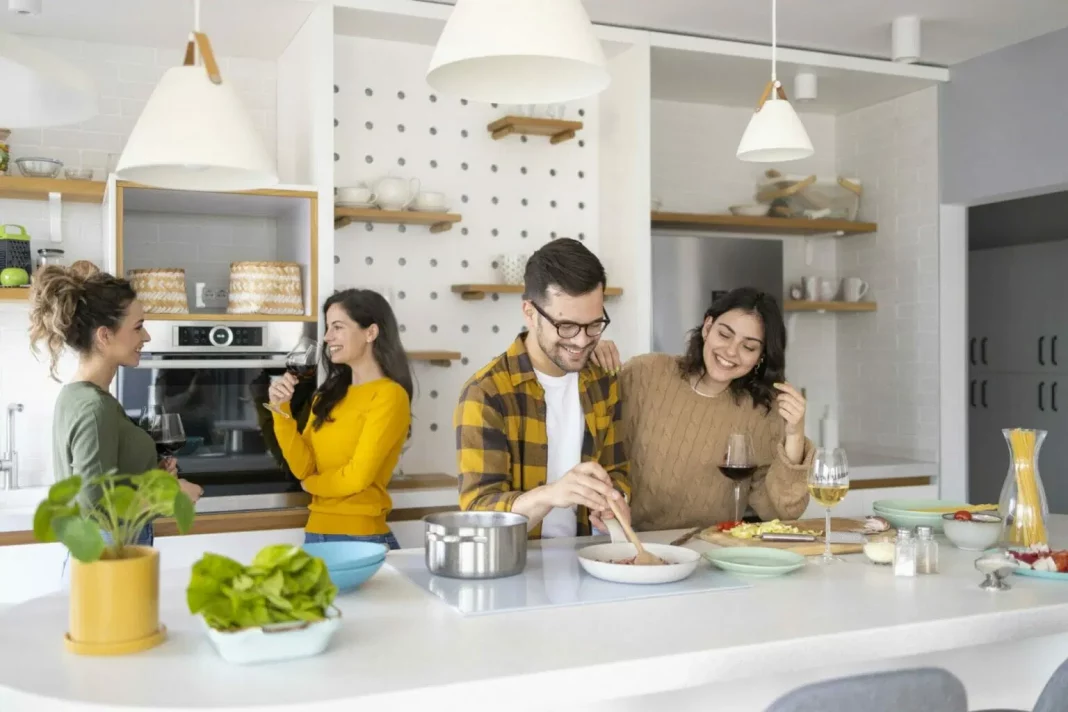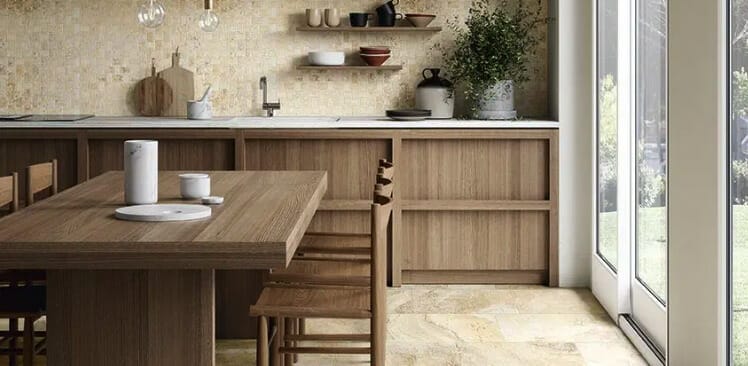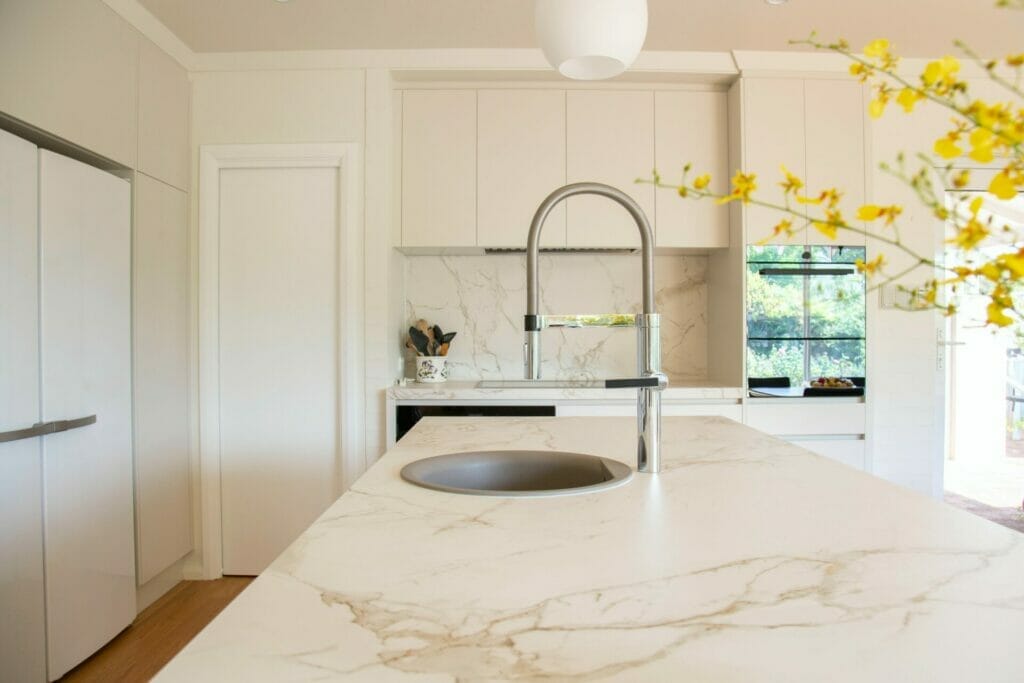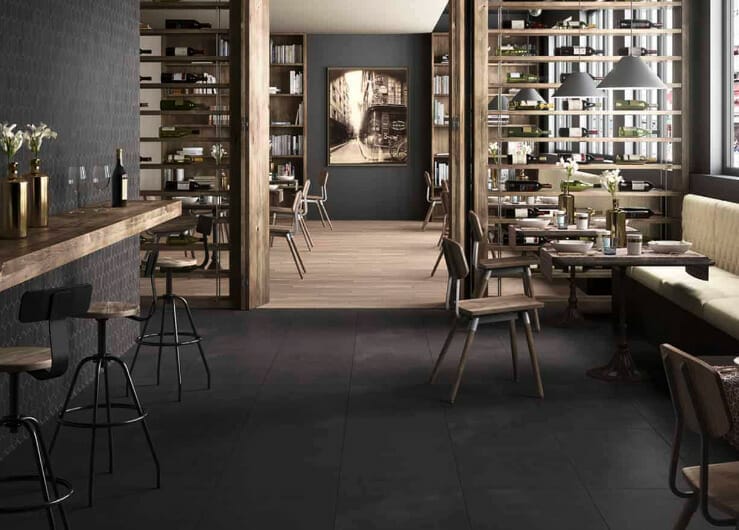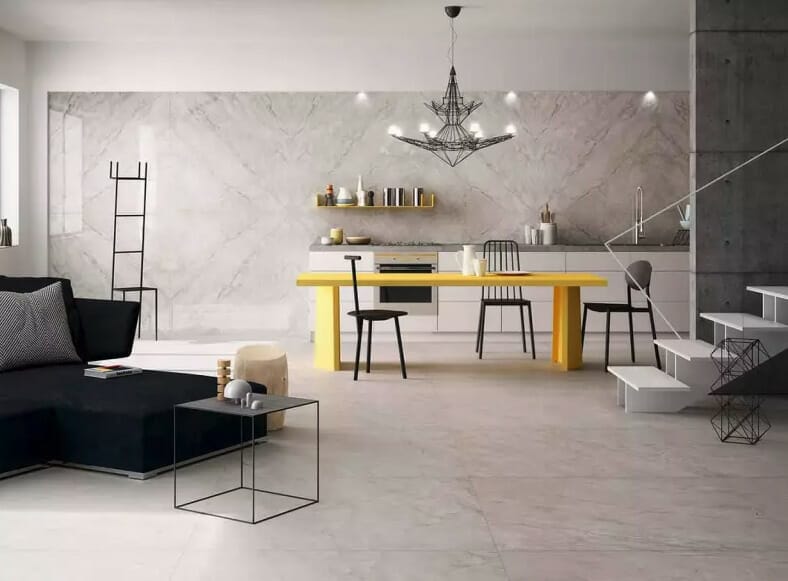The heart of every home, the kitchen, isn’t just a space where meals are prepared; it is also a place where memories are made, stories are shared, and where families and friends come together. Naturally, every aspect of its design plays a significant role in setting the mood and achieving the desired outcome.
While it might seem trivial, the choice of kitchen tiles can dramatically alter the aesthetics and practicality of your space. Whether this is through the soft hues of the wall tiles that create a serene environment or textured floor tiles that help prevent mishaps, your tile choice will definitely make a statement and it is important to get it right.
In this blog, we will explore the world of kitchen tiles, unravelling the myriad of options available and providing insights into tile colours, size and texture to help you make the best choice for your dream kitchen. Whether you are renovating, building a new kitchen or simply seeking some inspiration, we are here to give you some expert advice and kitchen tile ideas.
We will cover the following:
- The Role of Colour in Kitchen Tiles
- Exploring Tile Textures
- Determining the Right Size Tiles for Your Kitchen
- Prioritising Durability in Kitchen Tiles
- Cost Considerations
- Additional Factors to Consider
- Bringing It All Together
- Why Choose EMC Tiles as Your Tile Expert
#1: The Role of Colour in Kitchen Tiles
Colour is not just a visual element but it also evokes emotions. The shades we select, especially for integral parts of our home like the kitchen, possess the power to influence our mood, our perceptions and even our daily experiences.
Here’s why colour matters in kitchen design:
➡️ The Psychological Impact of Colours:
Every colour carries with it an emotion. For instance, blues evoke feelings of calmness and serenity, while reds can stimulate appetite and conversation. When you choose a tile colour, you are also selecting the ambient emotion of your kitchen. Do you want it to be a soothing space? Or do you envisage a lively and energising atmosphere?
➡️ Matching Tiles with the Overall Kitchen Theme:
Your tile colour should harmonise with the broader colour scheme of your kitchen. If you have a rustic or country-style kitchen, the earthy tones of natural stone tiles might be ideal. Conversely, for a modern and sleek design, monochromatic or bold contrasting colours might be more fitting.
➡️ Tips for Selecting a Colour Palette:
- Neutral versus Vibrant Shades: Neutrals such as beige, grey and white offer versatility and can be paired with various kitchen elements. On the other hand, vibrant shades can add a splash of personality and create focal points.
- The Trend of Contrasting and Complementary Colours: Creating a balance between your cabinets, countertops and tiles can lead to a visually appealing space. For example, dark cabinets might benefit from lighter tiles, and vice versa.
- Mood Boards and Samples: Before finalising any colour, create a mood board or get tile samples. At EMC Tiles you can order up to 3 FREE cut sample tiles (approx. 10cmx10cm). This allows you to visualise how they might look in your actual kitchen, avoiding any surprises later.
Taking the time to select the right shade of tiles will not only ensure that your kitchen looks good, but also that it feels right, providing an environment where you and your family will love to spend time.
#2: Exploring Tile Textures
The tactile experience of a kitchen space often goes unnoticed until we step on smooth kitchen floor tiles with bare feet or try to clean a particularly intricate design. The texture of kitchen tiles doesn’t just influence the aesthetic appeal but also contributes significantly to the room’s practical aspects.
Here’s why tile textures matter in kitchen design:
➡️ Benefits of Different Tile Textures:
- Visual Depth and Interest: Textured tiles can add depth and dimension to your kitchen, creating visual interest. They can break the monotony in larger spaces or add richness to smaller ones.
- Camouflaging Imperfections: Unlike smooth tiles, textured tiles are more forgiving when it comes to minor imperfections and spills. They can mask small scratches and stains, extending the fresh look of your kitchen.
- Enhanced Grip: Textured tiles offer better grip, especially when wet, which can be crucial in preventing accidents in the kitchen.
➡️ Smooth Tiles vs. Textured Tiles:
- Advantages of Smooth Tiles: Easier to clean, offer a sleek and modern look and are often preferred for walls or areas less prone to spills.
- Advantages of Textured Tiles: Provide better grip, create a rustic and earthy aesthetic, and are ideal for floors, especially near sinks or cooking areas.
➡️ Health and Safety Considerations:
Kitchen spills are inevitable. From water splashes to accidental drops and spillages, the kitchen floor needs to handle it all without becoming a hazard zone.
- Slip Resistance: Especially if you have young children or elderly family members, it is vital to select tiles that provide adequate slip resistance.
- Ease of Cleaning: While textured tiles might offer grip, they can also be more challenging to clean, trapping dirt or grime. It is essential to balance the need for texture with maintenance efforts.
➡️ Embracing a Mix of Textures:
Why settle for one when you can have both? Many homeowners are now opting for a mix of textured and smooth tiles, allowing for both aesthetic depth and functional smoothness where needed.
Textures in kitchen tiles offer a realm of possibilities and considering your kitchen’s daily dynamics and aesthetics can guide you to the ideal selection. Whether you lean towards the rustic charm of textured tiles or the seamless elegance of smooth ones, remember it is all about creating a harmonious blend of beauty and practicality.
#3: Determining the Right Size Tiles for Your Kitchen
Size matters when it comes to kitchen tiles. The dimensions of the tiles you choose can significantly impact the visual dynamics of the space, its maintenance needs, and even installation costs.
Here’s why tile size matters in kitchen design:
➡️ Perception of Space:
- Enhancing Spatial Perception: Larger tiles, with fewer grout lines, can make a space seem more expansive and open. They are especially beneficial in smaller kitchens where creating an illusion of space is a priority.
- Creating Intimacy: Conversely, smaller tiles can create a cosy, intimate feel, making them suitable for bigger kitchens that need a touch of warmth, or for spaces aiming for a vintage, retro look.
➡️ Small Tiles vs. Large Tiles:
- Advantages of Small Tiles:
- Flexibility in Design: Small tiles, often used in mosaics, allow for intricate patterns and designs.
- Adaptability: They can adapt better to uneven surfaces or curved areas.
- Advantages of Large Tiles:
- Fewer Grout Lines: This can mean easier cleaning and a more modern, seamless look.
- Statement Pieces: Large tiles can act as statement pieces, especially if they have a unique design or texture.
➡️ Using Tile Sizes to Create Patterns or Visual Interest:
- Combination of Sizes: Mix and match different tile sizes to create patterns, borders or focal points in your kitchen.
- Transitioning Spaces: Use different tile sizes to separate areas within the kitchen, such as the cooking area, dining room and breakfast bar.
➡️ Practical Considerations:
- Installation: Larger tiles might require a more levelled surface and can be slightly trickier to install than smaller ones.
- Replacement: Consider future replacements; smaller tiles can be easier to replace individually if one gets damaged.
- Cleaning: Grout lines, more prevalent with smaller tiles, may demand more frequent cleaning.
➡️ Tips for Making the Right Choices:
- Consider the Room’s Proportions: Ensure that the tile size is in proportion to the space. For example, overly large tiles might overwhelm a tiny kitchen space.
- Seek Professional Advice: If in doubt, consult with a tile expert such as EMC Tiles or an interior designer. They can provide insights and expert advice based on the specific dimensions and lighting of your kitchen.
In essence, while the tile’s design, colour and texture capture immediate attention, it is crucial not to overlook size. Whether you are gravitating towards petite patterned tiles or looking to make a grand tile statement, remember to factor in both your kitchen’s size, needs and character.
#4: Prioritising Durability in Kitchen Tiles
Kitchens are often bustling hubs of activity, and amidst the whirlwind of daily life, floor and wall tiles need to be able to withstand the constant wear and tear. Therefore, the durability of tiles is an essential factor to consider to ensure your investment stands strong for years to come.
Here’s why tile durability matters in kitchen design:
➡️ Different Types of Tiles:
- Ceramic Tiles: Made from clay and baked at high temperatures, they are durable and can resist moisture, making them a popular choice for kitchens. At EMC Tiles we offer an amazing selection of ceramic tiles in various shapes, sizes and finishes.
- Porcelain Tiles: A subtype of ceramic tiles, porcelain tiles are denser, less porous and show excellent resistance to moisture and stains. For beautiful porcelain tile designs, look no further than our vast collection.
- Stone Tiles: Including granite, marble and slate, these tiles add a touch of luxury to your home but they require periodic sealing to prevent staining. Take a look at our fantastic range of stunning stone tiles; a popular choice with our customers.
- Glass Tiles: Often used as kitchen wall tiles and backsplashes, they are resistant to stains and moisture but can be more prone to chipping.
➡️ Tile Ratings and What They Mean:
Understanding the various tile ratings can guide you to make an informed choice:
- PEI (Porcelain Enamel Institute) Rating: It measures a tile’s resistance to abrasion, with PEI 5 being the most durable and suitable for heavy foot traffic.
- Water Absorption Rates: Especially crucial for kitchens, tiles with low water absorption rates are less likely to stain or get damaged due to moisture.
- Coefficient of Friction: This measures slip resistance, with higher coefficients indicating better grip, essential for kitchen and bathroom floors.
➡️ Importance of Wear and Tear:
- High-Traffic Kitchens: If your kitchen sees frequent activity, from bustling family breakfasts to weekend baking marathons, prioritise tiles known for high durability.
- Stain Resistance: Given the myriad of ingredients and liquids in a kitchen, choosing kitchen tiles that resist staining can save significant cleaning effort.
- Resistance to Heat and Breakage: Especially if you are considering tiles for countertops or near stoves, the tiles’ ability to withstand heat without cracking is vital.
➡️ Maintenance and Longevity:
- Sealing Needs: Some tiles, especially natural stone ones, might require periodic sealing to maintain their look and resist stains.
- Cleaning Routine: While some tiles can be hassle-free and easy to clean, others might have special cleaning requirements or be more prone to holding onto stains and grime.
- Future Replacements: Durable tiles reduce the need for frequent replacements, ensuring your kitchen remains intact for longer.
➡️ Cost vs. Durability:
While it might be tempting to opt for cheaper tiles, it is important to consider the long-term implications. Investing a bit more in durable tiles can save costs in the long run due to fewer replacements and maintenance needs.
In short, while aesthetics and design are significant, the durability of kitchen tiles is equally important. It ensures the heart of your home remains beautiful and is able to withstand your culinary adventures for years to come.
#5: Cost Considerations
The financial aspect of designing a dream kitchen invariably plays a pivotal role in the decision-making. Tiles can considerably influence the budget, depending on the type, design and installation costs.
Here’s why tile cost matters in kitchen design:
➡️ Factors Influencing Tile Costs:
- Material: The very substance of the tile, be it porcelain, ceramic, natural stone or glass, can vary widely in price.
- Design and Specialty Tiles: Hand-painted, designer or custom-made tiles will naturally cost more than mass-produced ones.
- Tile Size and Thickness: Larger or thicker tiles may sometimes be pricier due to increased material use and production costs.
- Origin: Imported tiles, especially from renowned tile-producing regions, might carry a premium due to shipping and import duties.
➡️ Hidden Costs to Keep in Mind:
- Installation: While the tiles themselves have a price tag, don’t forget the labour costs. Installation prices can vary based on the complexity of the pattern, the tile type and labour costs.
- Maintenance: Some tiles, especially natural stone, might require sealants, special cleaners or periodic professional cleaning.
- Replacement Tiles: It is always a good idea to buy extra tiles for future repairs or replacements. This added cost ensures a match in case of damages.
➡️ Budgeting Tips:
- Prioritise Areas: Maybe opt for a luxurious backsplash, but you can choose a more budget-friendly option to cover larger floor areas.
- Mix and Match: Combining a few designer tiles with more affordable options can create a unique look without breaking the bank.
- DIY vs. Professional Installation: While DIY can save on labour costs, ensure you have the skills and tools needed. Incorrect installation can lead to increased costs in the long run.
- Seasonal Sales and Discounts: Tile manufacturers and retailers often have sales during particular seasons or clearance events. This can be an excellent opportunity to grab a good deal.
➡️ The Balance of Aesthetics and Budget:
Remember, while it is essential to stick to a budget, the cheapest option isn’t always the most cost-effective in the long run. Consider factors such as durability, maintenance and the overall impact on your home’s value.
By being informed, planning wisely, and seeking the right balance, you can achieve a stunning kitchen that aligns with both your design aspirations and budget.
#6: Additional Factors to Consider
While colour, texture, size, durability and cost are some of the most immediate decisions to mull over, there are also a handful of additional factors to take into consideration, such as:
➡️ Environmental Impact and Sustainability:
- Recycled Materials: Some tiles are made using recycled materials, which can reduce their environmental footprint.
- Local Sourcing: Choosing locally-produced tiles can minimise transportation-related emissions and often support community businesses.
- Longevity: Opting for durable tiles that don’t need frequent replacements is, in itself, a sustainable choice.
➡️ Installation Time and Complexity:
- Immediate Needs: Some tiles might be easy to install, while others, especially those requiring intricate patterns, might demand more time.
- Tile Backing and Adhesives: The type of adhesive or backing material required can impact both installation time and costs.
➡️ Adaptability to Underfloor Heating:
- If you are considering or already have underfloor heating, ensure that your chosen kitchen tiles are compatible. Some materials transmit heat better than others, optimising the efficiency of the heating system.
➡️ Light Reflection and Room Brightness:
- The glossiness and colour of tiles can influence the amount of light they reflect, which can either brighten or darken a room. This factor is especially crucial in kitchen areas with limited natural light.
➡️ Compatibility with Existing Decor and Appliances:
- Consider how the tiles will match or contrast with existing cabinets, countertops and appliances. A cohesive look can create a harmonious kitchen environment.
➡️ Acoustic Properties:
- Some tiles can amplify sound, while others might have a dampening effect. If you are sensitive to noise or have an open-plan space, it is worth considering how your tile choice might influence the room’s acoustics.
➡️ Personal Lifestyle and Habits:
- If you are someone who loves experimenting in the kitchen, stain-resistant tiles might be a good choice. Furthermore, if you have a bustling kitchen with kids running around, slip-resistant tiles would be ideal.
➡️ Seasonal and Climatic Factors:
- If you live in a region with considerable seasonal temperature variations, it is essential to choose tiles that can withstand these changes without cracking or wearing out quickly.
In summary, while the primary factors provide a solid foundation for your kitchen tiles decision, these additional considerations add depth and detail to your choices. They ensure that beyond the initial appeal, your tiles continue to serve and impress in the day-to-day life of your kitchen.
#8: Bringing It All Together
With a plethora of factors to weigh up and countless tile options to choose from, finalising your choice can seem like a daunting task. However, by systematically approaching the decision-making process and integrating all you have learned, you can’t fail to get it right.
✅ Reflect on Your Priorities:
- Primary Needs: Identify the top three aspects that matter most to you—whether this is durability, colour, cost or any other factor.
- Your Vision: Envision your dream kitchen. What feelings and aesthetics do you want to evoke? This will guide your tile choices in line with that vision.
✅ Research and Sample:
- Visit Tile Showrooms: Physically seeing and touching tiles can offer a perspective that online images can’t.
- Order Samples: Before committing, order small samples to test in your kitchen. Observe them at different times of the day and under various lighting conditions.
✅ Budgeting and Quotes:
- Seek Multiple Quotes: If you are hiring professionals for installation, get quotes from multiple sources to ensure you are getting a fair deal.
- Allocate a Contingency: Always set aside an additional 10-15% of your budget for unforeseen expenses.
✅ Professional Consultation:
- Use Expertise: Consider consulting with an interior designer or tile expert. Their insights can introduce perspectives or options you might have overlooked.
- Cross-check Durability Claims: If longevity is a top priority, verify the durability claims of your chosen tile with professionals or through independent reviews.
✅ Mock-up Layouts:
- Digital Tools: Use digital design tools or apps that allow you to visualise how different tiles will look in your kitchen.
- Physical Layout: If feasible, place larger tile samples in the intended areas to get a more accurate feel of the final look.
✅ Think Long-Term:
- Maintenance and Care: Ensure you are comfortable with the maintenance requirements of your chosen tiles.
- Flexibility for Decor Changes: Consider how flexible your tile choice is if you decide to change other aspects of your kitchen decor in the future.
#9: Why Choose EMC Tiles as Your Tile Expert
Are you looking to upgrade your kitchen? Then make EMC Tiles your destination for the latest kitchen tile trends!
➡️ Unrivalled Expertise and Experience
With over 40 years in the industry, there is not much we haven’t come across, and our dedicated team of experts is ready to guide you and advise you.
With a stunning array of innovative designs, advanced materials, vibrant colour choices, and cutting-edge technological integrations, we have something to match every taste and style. Our extensive range of kitchen tiles offers various sizes and textures, helping you to create your dream kitchen.


